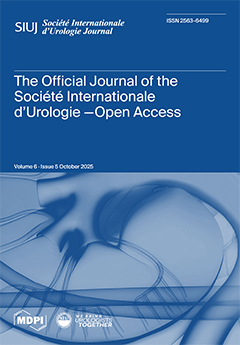The SIU wishes to extend its gratitude to the urologists who contributed their time to review abstract submissions for the 45th SIU Congress:Refaat Abusamra, Libya;Sanjai Addla, India;Kinju Adhikari, India;Neeraj Agarwal, United States;Madhu Agrawal, India;Sachin Agrawal, United Kingdom;Thomas Ahlering, United States;Shusuke Akamatsu, Japan;Peter
[...] Read more.
The SIU wishes to extend its gratitude to the urologists who contributed their time to review abstract submissions for the 45th SIU Congress:Refaat Abusamra, Libya;Sanjai Addla, India;Kinju Adhikari, India;Neeraj Agarwal, United States;Madhu Agrawal, India;Sachin Agrawal, United Kingdom;Thomas Ahlering, United States;Shusuke Akamatsu, Japan;Peter Albers, Germany;Salah Albuheissi, United Kingdom;Naif Alhathal, Saudi Arabia;Bedeir Ali-El-Dein, Egypt;Murtadha Almusafer, Iraq;Anastasios Anastasiadis, Greece;Mohamed Arafa, Qatar;Amandeep Arora, India;Zeeshan Aslam, United Kingdom;Hammad Ather, Pakistan;Widi Atmoko, Indonesia;Melanie Aubé-Peterkin, QC;Riccardo Autorino, United States;Ben Ayres, United Kingdom;Puskal Kumar Bagchi, India;Ganesh Bakshi, India;Mevlana Derya Balbay, Turkey;Neil Barber, United Kingdom;John Barry, United States;Jens Bedke, Germany;Elisa Berdondini, Italy;Gajanan Bhat, India;Amit Bhattu, United States;Naeem Bhojani, Canada;N I Bhuiyan, Bangladesh;Marta Bizic, Serbia;Damien Bolton, Australia;Vincenzo Borgna, Chile;Muhammad Bulbul, Lebanon;Gian Maria Busetto, Italy;Ana Gabriela Caballero Garcia, Mexico;Adam Calaway, United States;Amparo Camacho, United States;Kevin Campbell, United States;Francesco Capelan, Switzerland;Manuel Castanheira de Oliveira, Portugal;Christine Joy Castillo, Philippines;David Castro-Diaz, Spain;Arun Chawla, India;Manohar ChikkaMoga Siddaiah, India;Archil Chkhotua, Georgia;Sung Yong Cho, Korea, Rep [...]
Full article



